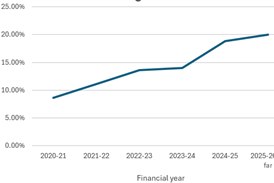A major new model of post-acute care is needed for the discharge and rehabilitation of patients following covid-19 infection, say Alice Murray, Clare Gerada, and Jackie Morris.
A comprehensive plan must be made for the 50 per cent of covid-19 patients who will require some form of ongoing care following admission to intensive care, with the goal of improving their long-term outcomes and freeing-up much-needed acute hospital capacity.

While the current focus is quite rightly on emergent cases, planning should be set in place to create post-acute care resources and facilities for the surge in numbers of people with the physical, psychological and functional consequences of prolonged ITU stays and or hospital admission following covid-19 infection.
One potential solution is to provide mass facilities, on a scale to match the Nightingale Hospitals in so-called “Centres of Excellence”, requisitioned for those who survive but need care and cannot return to their own homes, with both residential and day care units available.
Multidisciplinary teams of experts would manage the rehabilitation of large volumes of patients following discharge from both ITU and acute wards, providing ongoing integrated care and support for the cognitive, respiratory, psychiatric and physical effects of covid-19.
Background
At present there is little information about the health, rehabilitation and social needs of those who survive covid-19. Data are limited regarding the proportion of patients with covid-19 in other countries who have needed post-acute care, and the longer-term outcomes of these patients. However, the NHS discharge to assess model (COVID -19 Hospital Discharge Service requirements 19 March 2020) 1 assumes that:

- Fifty percent of people will require no input from health and social care,
- Forty five percent will need support from health and social care
- Four percent will require rehabilitation in a bedded setting
- One percent for whom discharge from the acute sector is not an option.
After long periods in intensive care patients experience physical, psychological and cognitive dysfunction. Cognitive impairment is said to occur in 30-80 per cent of ITU survivors. New physical impairments occur in 25-80 per cent of patients. Post-traumatic stress disorder varies in severity and is thought to occur in between 8-57 per cent of patients.2 Survivors can also experience anxiety and depression. In particular those with Acute Respiratory Distress Syndrome can develop sleep deprivation, bone disease, thirst, delirium and pain. Longer-stay patients are more likely to develop muscle wasting, neuropathies, loss of mobility, loss of function and weakness. The under-recognised Post Intensive Care Syndrome is associated with long-term poor outcomes especially for patients who have had ARDS, prolonged ventilation and/or sepsis.2,3
We do not know the longer-term physical, physiological and psychological outcomes for this novel covid virus, but there is some evidence from the SARS, MERS, influenza A (H7N9) and H1N1 epidemics describing longer-term ongoing reduction in pulmonary function, reduced quality of life as well as physical function and emotional well-being. 4-9.
A failure to identify, diagnose and treat these functional problems, disabilities and cognitive impairments in individuals with multiple co-morbidities following ITU care is worrying. Without a coordinated approach and support patients may experience, psychological and physical deterioration. This contributes to prolonged lengths of hospital stay, reduced acute bed capacity, increased readmissions and poor long-term outcomes for survivors. There is also concern that discharging patients into unexposed community facilities presents an ongoing risk of transmission, as the length of time patients remain infectious is not yet clear.
At present there are insufficient resources in terms of beds and facilities for those requiring longer rehabilitation. Community services are already overstretched and overloaded and will have a limited ability to track post-covid patients after discharge. While there is recognition that some people will require rehabilitation, placement in a care home will not be appropriate for most people requiring rehabilitation to achieve their maximum potential. They may no longer need ITU, but they will still need medical attention, observation, therapy, treatment and follow up for their medical and physical problems arising from covid-19.
What is to be done?
A potential solution to the issue of a surge in rehabilitation requirements is the development of mass facilities, along the lines of a “Centre for Excellence” model. This would allow for a high volume of patients to be treated by multidisciplinary teams of experts. The concentration of care with co-located services (for example in requisitioned hotels, gyms or football stadia) would provide higher quality, efficient, patient-focused care, with improved long-term patient outcomes. This will facilitate the development of streamlined and integrated primary and secondary care pathways from admission to discharge and follow up. The benefit of single site services also includes those of simplified distribution models, for example the provision of PPE for staff, and testing services for staff. Face-to-face care would work hand-in-hand with the current virtual follow-up practices already in place in a number of hospitals. Patient outcomes would be measured and tracked to guide further improvements in care.
Conclusion
A new model of care should be developed alongside the Nightingale hospitals in order to link ITU, post-acute care, domiciliary and primary care. Larger specialist facilities would increase community capacity for ongoing rehabilitation – freeing up acute beds, shortening lengths of stay and improving patient outcomes, reducing the significant long-term adverse effects of covid on physical and mental health. Covid-specific rehabilitation guidelines and criteria for post-acute care, alongside simple outcome measurement would be developed. A failure to address the significant post-acute care needs of covid-19 patients will risk creating greater challenges further down the line.
- Jackie Morris is a retired consultant geriatrician, previously of St Mary’s Hospital, Paddington, Royal Free Hospital Trust, and University College Hospital Trust
- Alice Murray is a general surgery registrar in north London and was a Harkness Fellow in healthcare policy and practice in 2017.
- Clare Gerada is s Senior GP partner at The Harley Group, London.
References
1. England N. COVID-19 Hospital Discharge Service Requirements. In: Government O, ed: Crown Copyright 2020.
2. Colbenson GA, Johnson A, Wilson ME. Post-intensive care syndrome: impact, prevention, and management. Breathe (Sheff). 2019;15(2):98-101.
3. Davidson JE, Harvey MA, Bemis-Dougherty A, Smith JM, Hopkins RO. Implementation of the Pain, Agitation, and Delirium Clinical Practice Guidelines and promoting patient mobility to prevent post-intensive care syndrome. Crit Care Med. 2013;41(9 Suppl 1):S136-145.
4. Chen J, Wu J, Hao S, et al. Long term outcomes in survivors of epidemic Influenza A (H7N9) virus infection. Sci Rep. 2017;7(1):17275.
5. Liu W, Peng L, Liu H, Hua S. Pulmonary Function and Clinical Manifestations of Patients Infected with Mild Influenza A Virus Subtype H1N1: A One-Year Follow-Up. PLoS One. 2015;10(7):e0133698.
6. Ong KC, Ng AW, Lee LS, et al. 1-year pulmonary function and health status in survivors of severe acute respiratory syndrome. Chest. 2005;128(3):1393-1400.
7. Wu X, Dong D, Ma D. Thin-Section Computed Tomography Manifestations During Convalescence and Long-Term Follow-Up of Patients with Severe Acute Respiratory Syndrome (SARS). Med Sci Monit. 2016;22:2793-2799.
8. Tansey CM, Louie M, Loeb M, et al. One-year outcomes and health care utilization in survivors of severe acute respiratory syndrome. Arch Intern Med. 2007;167(12):1312-1320.
9. Batawi S, Tarazan N, Al-Raddadi R, et al. Quality of life reported by survivors after hospitalization for Middle East respiratory syndrome (MERS). Health Qual Life Outcomes. 2019;17(1):101.



























2 Readers' comments